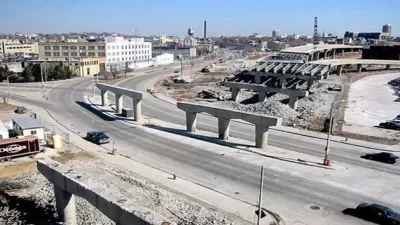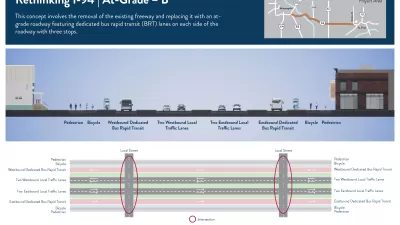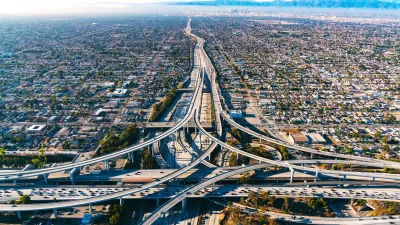City and state officials hope the proposal to turn part of I-375 into a walkable boulevard will help bring back businesses and economic vitality to the area.

A one-mile stretch of Interstate 375 in Detroit could become a "livable, walkable, rideable" boulevard that accommodates pedestrians, cyclists, and other road users. Eli Newman reports on a plan being formed by the state and the city to reconnect the neighborhood that the interstate sliced through decades ago.
"Construction on I-375 started in 1959, displacing African-American businesses and residential life in Black Bottom and Paradise Valley. [Michigan Governor Gretchen] Whitmer says there is 'a sad history' behind the construction of the freeway, which had 'devastating impacts.' The boulevard project could unify the surrounding areas today." The article points out that "According to the Detroit Historical Society, there were more than 300 Black-owned businesses in the district during the 1920s, when many African American migrants from the South came to the near east neighborhoods."
Transforming the freeway to a boulevard could "improve walkability and re-establish business along the corridor," according to Detroit mayor Mike Duggan. "Duggan says the I-375 project could resemble recent streetscape restoration in Detroit like the “Avenue of Fashion” section of Livernois. He says there would need to be a combined city and state authority that oversees the development."
The Michigan Department of Transportation (MDOT) anticipates construction could begin in 2027 and last three years, notes Newman. "The state is holding community meetings to discuss design plans following initial approval from the federal government."
FULL STORY: Plans to turn I-375 in downtown Detroit into a boulevard move forward

Alabama: Trump Terminates Settlements for Black Communities Harmed By Raw Sewage
Trump deemed the landmark civil rights agreement “illegal DEI and environmental justice policy.”

Study: Maui’s Plan to Convert Vacation Rentals to Long-Term Housing Could Cause Nearly $1 Billion Economic Loss
The plan would reduce visitor accommodation by 25% resulting in 1,900 jobs lost.

Why Should We Subsidize Public Transportation?
Many public transit agencies face financial stress due to rising costs, declining fare revenue, and declining subsidies. Transit advocates must provide a strong business case for increasing public transit funding.

Paris Bike Boom Leads to Steep Drop in Air Pollution
The French city’s air quality has improved dramatically in the past 20 years, coinciding with a growth in cycling.

Why Housing Costs More to Build in California Than in Texas
Hard costs like labor and materials combined with ‘soft’ costs such as permitting make building in the San Francisco Bay Area almost three times as costly as in Texas cities.

San Diego County Sees a Rise in Urban Coyotes
San Diego County experiences a rise in urban coyotes, as sightings become prevalent throughout its urban neighbourhoods and surrounding areas.
Urban Design for Planners 1: Software Tools
This six-course series explores essential urban design concepts using open source software and equips planners with the tools they need to participate fully in the urban design process.
Planning for Universal Design
Learn the tools for implementing Universal Design in planning regulations.
Smith Gee Studio
Alamo Area Metropolitan Planning Organization
City of Santa Clarita
Institute for Housing and Urban Development Studies (IHS)
City of Grandview
Harvard GSD Executive Education
Toledo-Lucas County Plan Commissions
Salt Lake City
NYU Wagner Graduate School of Public Service





























